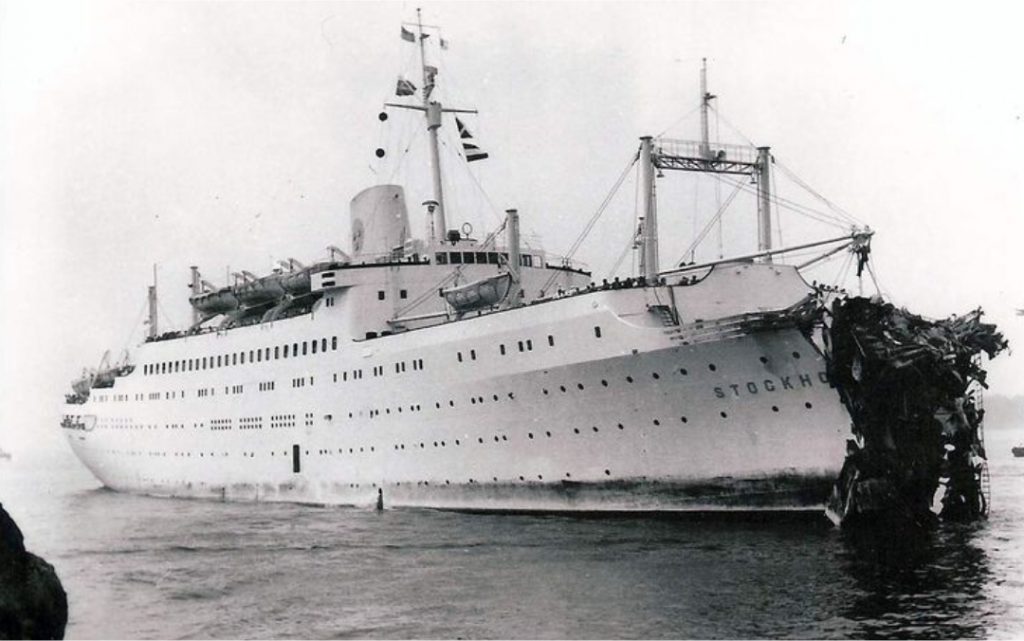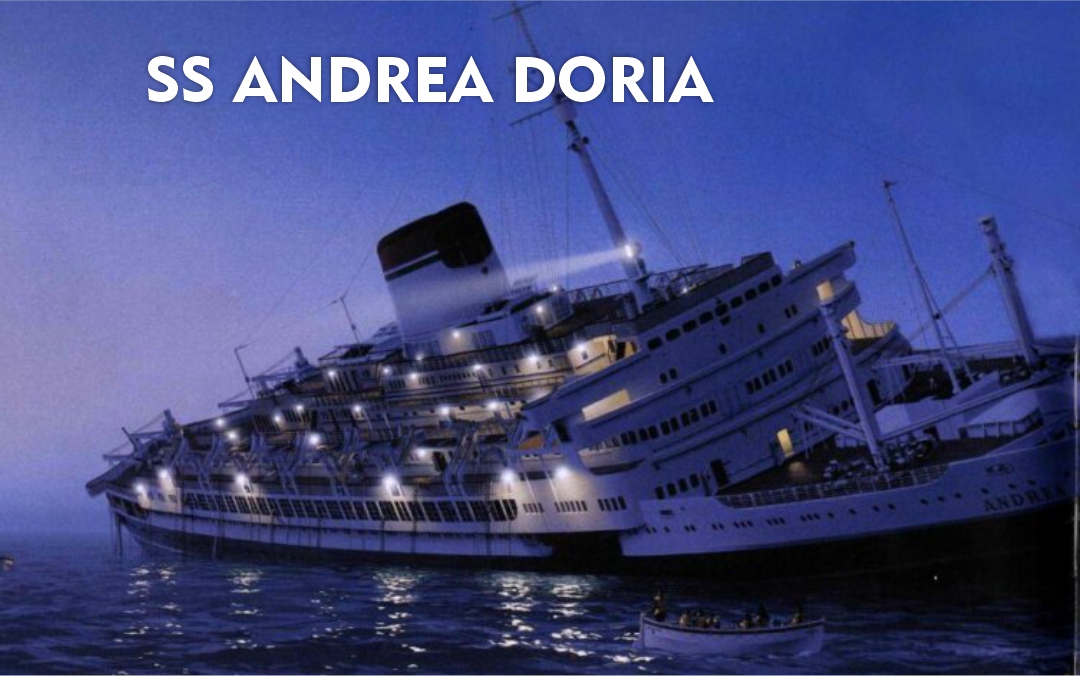Built-in 1951 by Ansaldo Shipyards in Genoa Italy, SS Andrea Doria was a flagship of the Italia de Navigazione S.p.A.- famously known as Italian Line. Measuring some 697 feet (212 meters) in length, it could carry approximately 1,240 passengers. Named after the 15th century Genoese Admiral Andrea Doria, she was placed on the Genoa to New York City run and embarked on her maiden voyage in 1953. Her sister ship was the Cristoforo Colombo. It was said to be the biggest, fastest, safest, and most beautiful ship in Italy after World War II.
The liner was noted for its luxuries, and to take advantage of the sunnier southern beautiful sceneries, which included three outdoor swimming pools and numerous works of art. In addition, the ship was equipped with notable safety features, such as 11 watertight compartments as well as radar, which was then a relatively new technology. By the mid-1950s, with the post-war passenger boom at its peak, more than 50 passenger liners sailed the sea lanes between Europe and America. Among the most splendid were two new ships of the Italian Line, the Cristoforo Colombo, and the Andrea Doria.
On 25 July 1956, while Andrea Doria was approaching the coast of Nantucket, Massachusetts, the United States, bound for New York City, the eastbound Stockholm of the Swedish American Line collided with her in one of history’s most infamous maritime disasters.
The consequent shortage of lifeboats resulted in significant loss of life. The vessel Andrea Doria had 1,134 passengers and 572 crew members on board. SS Andrea Doria and MS Stockholm’s collision resulted in the death of 51 people in total, however, Stockholm helped in the rescue and ended up carrying 327 passengers and 245 crew members from Andrea Doria, in addition to her own passengers and crew. The luxury liner- Andrea Doria capsized and sank the following morning. As the two ships approached each other through the fog, at a combined speed of 40 knots (74 km/h), each was aware of the presence of another ship, but was guided only by radar; they apparently misinterpreted each other’s course.
In the critical minutes before the collision, Andrea Doria gradually steered to port, attempting a starboard-to-starboard passing, while Stockholm turned about 20° to its starboard, an action intended to widen the passing distance of a port-to-port passing. By the time the crews realized that they were on a collision course, they could not avoid it, the two ships collided, Stockholm striking the side of Andrea Doria at almost a 90° angle, Stockholm‘s sharply raked ice-breaking prow piercing Andrea Doria‘s starboard side about one-third of her length from the bow.

The Stockholm penetrated the Andrea Doria‘s hull to a depth of nearly 40 feet. Below the waterline, five fuel tanks on Andrea Doria’s starboard side were torn open, and they filled with thousands of tons of seawater. Meanwhile, the air was trapped in the five empty tanks on the port side, causing them to float more readily. The combination of the flooded tanks on one side and the empty tanks on the other left Andrea Doria with a list which within a few minutes of the collision exceeded 20°. The severe list would gradually pull the tops of the bulkheads along the starboard side below the level of the water, allowing seawater to flow down corridors and stairwells. In addition, the generator room flooded rapidly, contributing to a loss of electricity to the stricken liner. In the end, the heavy fog would be the main reason given as the cause of the accident. However, at the time, these factors were apparent to some observers. The officers of the Andrea Doria had not followed proper radar procedures or used the plotting equipment available in the chartroom adjacent to the bridge of their ship to calculate the position and speed of the other (approaching) ship. Thus, they failed to realize Stockholm’s size, speed, and course. The Andrea Doria had not followed the proper “Rules of the Road” in which a ship should turn to the right (to starboard) in case of a possible head-on crossing at sea. As the Stockholm turned right, the Andrea Doria turned left (to port) and there was no way to avoid the collision. The captain of the Andrea Doria was deliberately speeding in heavy fog, an admittedly common practice on passenger liners. The applicable “Rules of the Road” required speed to be reduced to a stopping distance within half the distance of visibility. At a practical level, this would have meant reducing the speed of the ship to virtually zero in the dense fog experienced.
Prominent maritime attorneys represented the ships’ owners. Dozens of attorneys represented victims and families of victims. Officers of both ship lines had testified, including the officers’ in-charge of each ship, with more scheduled, when an out-of-court settlement was reached, and the hearings ended abruptly. Both shipping lines contributed to a settlement fund for the victims. Each line sustained its own damages. For the Swedish-American Line, this was estimated at $2 million, half for repairs to the Stockholm’s bow, and a half for lost business during repairs. The Italian Line sustained a loss of the full value of the Andrea Doria, estimated to be $30 million.
Today, resting in some 240 feet of the North Atlantic water, the wreck of Andrea Doria has become a popular site among scuba divers, being called “Mount Everest of scuba diving.” Stockholm was repaired at a cost of $1 million. Today, it sails as a refurbished cruise ship, the M.S. Caribe. The story of the accident was retold by Alvin Moscow in his book Collision Course: The Story of the Collision Between the ‘Andrea Doria’ and the ‘Stockholm’ published in 1959.
To be concluded.






